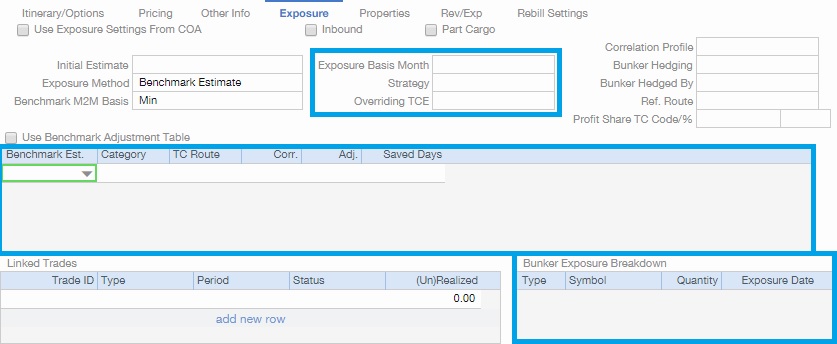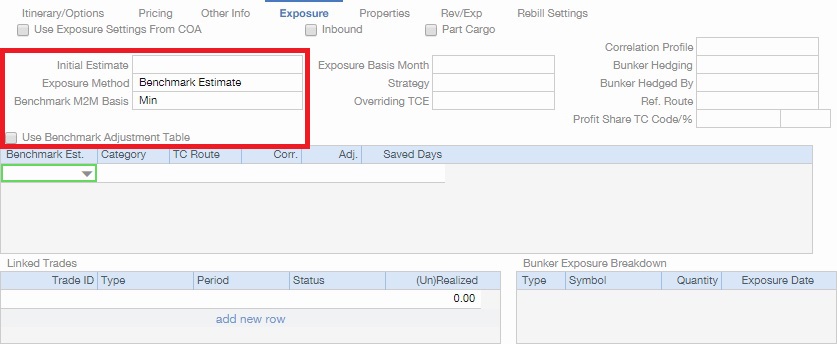IMOS - Working With Benchmark Estimates
Home > Trading & Risk > Working With Benchmark Estimates
Configuration flag CFGEnableBenchmarkEstimate must be enabled.
You can do any of the following with Benchmark Estimates:
Calculating Exposure Using a Benchmark Estimate
You can create a Benchmark Estimate to mark to market a Cargo contract when there is no $/ton index available but there are relevant $/day (TC) and bunker indices.
If there were a published index in $/ton, you could do the following calculation to find the future value of your contract:
Net P&L = (Market Freight Rate/Ton - Contract Freight Rate/Ton) * Contract Qty
However, as there are only $/day and bunker indices, you can estimate the Net P&L of the contract arising from shifts in the prices of these indices using the benchmark calculation.
Bunker Exposure
The bunker exposure is calculated as follows:
Bunker Exposure = (Fuel 1 Rate - Fuel 1 Market Rate) * Benchmark Fuel 1 consumption tons + (Fuel 2 Rate - Fuel 2 Market Rate) * Benchmark Fuel 2 consumption tons + ...
TC Exposure
The TC exposure question is: What Freight Rate would you need to pay for someone’s vessel on the market to carry your cargo for you, given the forward bunker rate? The answer is: The owner of the vessel would have to earn the same TCE from transporting your cargo as the Time Charter rate on the same route.
To use a Voyage Estimate to manually find that Freight Rate, you have to fix the TCE to be equal to the market rate (by selecting the TCE check box on the Estimate P&L panel and entering the value in the TCE field), and also change the bunker rates to the market bunker rates. Then use the freight rate that the Estimate will back-calculate in this formula to retrieve the Net P&L:
Net P&L = (Market Freight rate/ton - Contract Freight rate/ton) * Contract Qty
To get the TC exposure figure, use the following formula:
TC Exposure = Net P&L - Bunker Exposure
Multi-Cargo Benchmark Estimate
With configuration flag CFGEnableMultiCargoBenchmarkEstimates, multiple Cargoes can be added to a Benchmark Estimate and scheduled on a voyage.
The TCE and Bunker price from the multi-cargo Benchmark Estimate are used for the M2M valuation the same way it is used for the standard Benchmark Estimate. The bunker tonnage and voyage days are prorated out to the Cargoes based on the CP quantities.
Cargoes created from a multi-cargo Benchmark Estimate are linked by a Benchmark Link ID field on the Cargo.
Linked Cargoes
Exposure details are synced across linked Cargoes.
Changing any of the following synced fields on the Exposure tab of a linked Cargo updates the other linked Cargoes:

Exposure Basis Month
Strategy
Overriding TCE
Bunker Estimate grid
Bunker Exposure Breakdown grid
Changing any of the following fields on a linked Cargo breaks the link; when it is broken, it cannot be restored. The Cargoes must be re-created from the Benchmark Estimate to reestablish the link.

Initial Estimate
Exposure Method
Benchmark M2M Basis
Use Benchmark Adjustment Table
If one linked Cargo is removed, the link with the other Cargoes remains.
A multi-cargo Benchmark Estimate can only be selected from the Exposure tab if the Cargo is linked to the multi-cargo benchmark estimate through the Benchmark Link ID.
Linking a Benchmark Estimate and a Cargo
The following workflow describes how a trader can create a Cargo using a Voyage Estimate and link them so that the Mark-to-Market of the Cargo is using that Estimate.
Create an Estimate.
Note: The vessel does not need to be the actual vessel that will perform the Cargo contract. In many cases, traders will use standard benchmark vessels and standard ballasting positions for this stage.
On the Estimate Properties panel, select the Benchmark check box. The Fix Contract button appears on the toolbar.
On the Estimate toolbar, click Fix Contract and then click Fix Cargo. A Cargo contract is created with the information from the CP Terms Details form.
On the Cargo Exposure tab:
The Exposure Method is set to Benchmark Estimate by default, and the Voyage Estimate that generated the Cargo is linked there.
Set the TC Route, Correlation, and Benchmark Bunker Curve.
If you want to use a different Benchmark Estimate at a later stage to evaluate the Cargo Exposure more accurately, you can insert a new line and select a different Estimate in the Benchmark Estimate table.
When a voyage with multiple Cargoes is scheduled, all linked Cargoes are pulled into the voyage.
Creating an Estimate from a Cargo-Linked Benchmark
You can create an Estimate from a Cargo based on the linked Benchmark Estimate:
On the Cargo toolbar, click Estimate and then click Add Cargo To New Estimate From Benchmark.
A new Estimate appears in Worksheet view.
Changing a Benchmark Estimate Itinerary to Match a Cargo
Using the Trading Profile, you can dynamically change a Benchmark Estimate Itinerary according to the Cargo and use it in the exposure calculation. Follow these steps:
Create a Benchmark Estimate.
On CP Terms Details, specify all the itinerary options.
Verify that the Freight Type is Flat Rate.
On the Benchmark Estimate toolbar, click Fix Contract and then click Fix Cargo.
On the newly created Cargo, set the Freight Type to Use Price Matrix.
On the Cargo Pricing tab, click the Update from Opts button and update all the pricing details.
On the Cargo Exposure tab, set the Benchmark Route and Correlation, and the Benchmark Bunker Curve, if relevant.
On the Trading Profile, select the Overwrite Itinerary on Benchmark Est check box.
